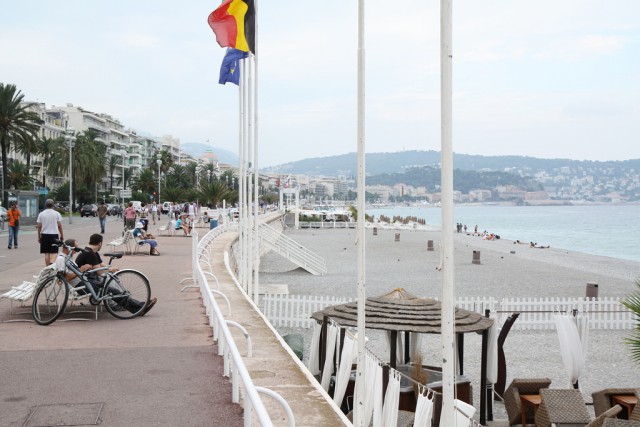Nice-like attacks could become more commonplace: security analysts
WASHINGTON (Talk Media News) – The murder of 84 civilians and the injury of more than 200 others Thursday night in Nice raises questions as to whether terrorist groups are changing their attack methods.
Nice was celebrating Bastile Day when French-Tunisian Mohamad Lahouaiej Bouhel, 31, drove a truck into an unsuspecting crowd in a deliberate attempt to kill as many people as possible. Bouhel was shot and killed by police while attempting to flee the scene of the attack. Police later found hand grenades and an arsenal of miscellaneous weapons inside his truck.
Bouhel was affiliated with ISIS according to the terrorist group.
Douglas Poppa, a former military police officer who also served as director of security at the now-defunct Riviera hotel & casino in Las Vegas, told TMN most Americans are not familiar with the mass murder method employed in Nice.
“It’s not a new strategy,” Poppa said. “It’s something that has been known for years (by security and intelligence experts) but it hasn’t been utilized, as far as I know, at least in the United States.”
Poppa said the possibility of another Nice-style terror attack is not improbable because it only requires access to a vehicle.
“Yes the possibility is that could be something that somebody would do in the future because it doesn’t require a whole lot of equipment,” Poppa said. “It requires you just getting a vehicle.” “Whether you buy it, rent it, or steal it.” And now you have a weapon.”
Poppa said there is little law enforcement can do to prevent the repetition of Nice-style terror attacks unless there are visible warning signs such as declarations of intent on social media. He also said that sometimes those types of indicators prove insufficient as well.
“There’s nothing they can do beforehand unless he’s on social media and their talking about it,” Poppa said. “And a lot of times that doesn’t even stop it.”
But Poppa did say that having law enforcement in close proximity to potential soft targets could help minimize casualties because that would make it much easier to neutralize potential terrorists.
“If there’s law enforcement or security personnel around the only way you would stop a truck like that from running down the street is to kill the driver,” Poppa said. “So you would have to have police or security personnel who are armed in the vicinity of where these things are happening to take out the driver of the truck to minimize the causalties.”
Dan Gabriel, a former CIA counter-terrorism officer who served tours in Iraq and Afghanistan, said terrorist literature has for sometime now encouraged violent extremists to alter their attack methods so as to produce Nice-like carnage.
“As early as 2010 we saw in the second issue of the jihadist magazine “Inspire” a how-to guide for these sorts of tactics,” Gabriel said. “It plainly detailed how an attacker could inflict maximum carnage on a crowd of pedestrians with a motor vehicle, exactly as we saw in Nice.”
Gabriel said American political leaders and law enforcement cannot halt or eliminate terrorist threats until they are willing to acknowledge that the terrorists are motivated by religious ideology. He said the threat is not simply violent extremism, but violent Islamic extremism.
“Fight the ideology,” Gabriel said. “And that means demanding that our political leadership in the U.S. recognize this threat and call it by name.” “It’s not “violent extremist ideology”- it’s “violent Islamic extremism.”
Gabriel also said law enforcement should emulate security procedures commonly featured in countries more accustomed to dealing with terrorism if they wish to protect Americans gathered in densely populated venues.
“Look to a mega city like Jakarta, Indonesia, which continues to face the specter of exploding embassies, bars, and hotels,” Gabriel said. “The public entrance to every mall, office building, and place of worship will be guarded by metal detectors and private security.”
Gabriel predicted that invasive security procedures incorporated abroad will inevitably become commonplace in the U.S.
“Over the long term, our understanding of architecture and city planning will begin to incorporate these elements into design,” Gabriel said. “Security measures of this nature will be no more unusual than seeing a fire escape on an old city building.”
This article is republished with permission from Talk Media News

Bryan is an award-winning political journalist who has extensive experience covering Congress and Maryland state government. His work includes coverage of the election of Donald Trump, the confirmation hearings of Supreme Court Justice Brett Kavanaugh and attorneys general William Barr and Jeff Sessions-as well as that of the Maryland General Assembly, Gov. Larry Hogan, and the COVID-19 pandemic.
Bryan has broken stories involving athletic and sexual assault scandals with the Baltimore Post-Examiner.
His original UMBC investigation gained international attention, was featured in People Magazine and he was interviewed by ABC’s “Good Morning America” and local radio stations. Bryan broke subsequent stories documenting UMBC’s omission of a sexual assault on their daily crime log and a federal investigation related to the university’s handling of an alleged sexual assault.

